ANGLES IN QUADRILATERALS WORKSHEET
Problem 1 :
Four angles of a quadrilateral are in the ratio 3 : 4 : 5 : 6. Find its angles.
Solution :
In a quadrilateral, the angles are in the ratio 3 : 4 : 5 : 6. Then the interior angles will be 3x, 4x, 5x and 6x.
Sum of interior angles of quadrilateral = 360
3x + 4x + 5x + 6x = 360
18x = 360
x = 360/18
x = 20
Applying the value of x in 3x, 4x, 5x and 6x, we get
3(20) ==> 60°
4(20) ==> 80°
5(20) ==> 100°
6(20) ==> 120°
So, the required angles are 60°, 80°, 100° and 120°.
Problem 2 :
The adjacent angels of a parallelogram are (3x - 4)° and (3x + 10)°. Find the angles of a parallelogram.
Solution :
In a parallelogram, opposite sides are parallel and equal. Adjacent angles will lie in between parallel sides.
(3x - 4) + (3x + 10) = 180
6x + 6 = 180
6x = 180 - 6
6x = 174
x = 29
Applying the value of x,
|
= 3x - 4 = 3(29) - 4 = 87 - 4 = 84 |
= 3x + 10 = 3(29) + 10 = 87 + 10 = 97 |
So, the required angels are 84° and 97°.
Problem 3 :
Three angles of a quadrilateral are in the ratio 4 : 6 : 3. If the fourth angle is 100°, find the three angles of a quadrilateral.
Solution :
The three angles are 4x, 6x and 3x
Sum of the interior angles = 360
4x + 6x + 3x + 100 = 360
13x = 360 - 100
13x = 260
x = 260/13
x = 20
Applying the value of x in 4x, 6x and 3x, we get
4(20) = 80°
6(20) = 120°
3(20) = 60°
So, the required angles are 80°, 120°, 60° and 100°
Problem 4 :
Find x + y + z + w
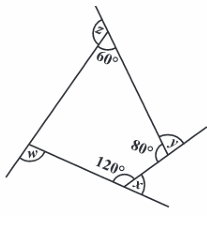
Solution :
By observing the figure, x and 120 are supplementary.
x + 120 = 180
x = 180 - 120
x = 60 ----(1)
y and 80 are supplementary.
80 + y = 180
y = 180 - 80
y = 100 ----(2)
z and 60 are supplementary.
z + 60 = 180
z = 180 - 60
z = 120 ----(3)
x + y + z + another interior angle = 360
60 + 100 + 120 + interior angle = 360
interior angle = 360 - 280
= 80
w = 180 - 80
w = 100 ----(4)
(1) + (2) + (3) + (4)
= 60 + 100 + 120 + 100
x + y + z + w = 380°
Problem 4 :
Find the angle x.
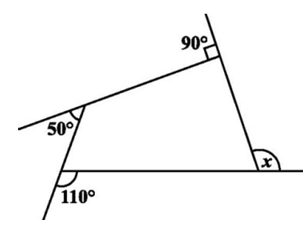
Solution :
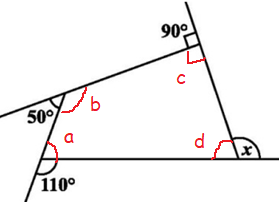
a = 180 - 110 ==> 70
50 + b = 180
b = 180 - 50 ==> 130
90 + c = 180
c = 180 - 90 ==> 90
d + x = 180 -----(1)
Sum of interior angles of a quadrilateral = 360
a + b + c + d = 360
70 + 130 + 90 + d = 360
290 + d = 360
d = 360 - 290
d = 70
By applying the value of d in (1), we get
70 + x = 180
x = 180 - 70
x = 110
Problem 5 :
Two adjacent angles of a parallelogram are as 2 : 3. Find the measure of each of its angles.
Solution :
Sum of adjacent angles of parallelogram = 180
Since the adjacent angles are in the ratio 2 : 3, let the angles be 2x and 3x.
2x + 3x = 180
5x = 180
x = 180/5
x = 36
2x = 2(36) ==> 72
3x = 3(36) ==> 108
So, the required angles are 72, 72, 108 and 108.
Problem 6 :
The angle between the two altitudes of a parallelogram through the same vertex of an obtuse angle is 80° . Find the obtuse angle.
Solution :
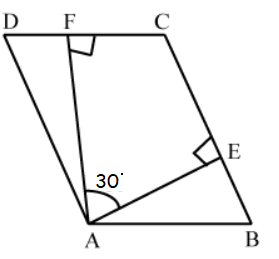
In the parallelogram above,
AF and AE are altitudes of the parallelogram.
In the quadrilateral AEFC,
<AFC = <AEC = 90
<FAE = 30
Here the obtuse angle is <FCE
30 + 90 + 90 + <FCE = 360
30 + 180 + <FCE = 360
210 + <FCE = 360
<FCE = 360 - 210
= 150
So, the required obtuse angle is 150 degree.
Problem 7 :
In a figure given below, ABCD is a parallelogram, what is the value of x ?
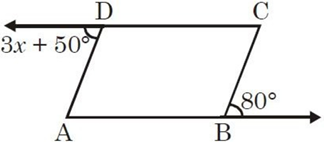
Solution :
Since ABCD is a parallelogram, AB and DC are parallel.
<ABC + 80 = 180
<ABC = 180 - 80
<ABC = 100
Then <ADC = 100 (opposite angles will be equal)
3x + 50 = 80
3x = 80 - 50
3x = 30
x = 10
So, the value of x is 10.
Kindly mail your feedback to v4formath@gmail.com
We always appreciate your feedback.
©All rights reserved. onlinemath4all.com
Recent Articles
-
Digital SAT Math Problems and Solutions (Part - 150)
Apr 25, 25 11:46 AM
Digital SAT Math Problems and Solutions (Part - 150) -
AP Calculus AB Problems with Solutions (Part - 19)
Apr 24, 25 11:10 PM
AP Calculus AB Problems with Solutions (Part - 19) -
AP Calculus AB Problems with Solutions (Part - 18)
Apr 24, 25 11:06 PM
AP Calculus AB Problems with Solutions (Part - 18)
